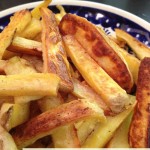
Fermented Fries
Ingredients
- Potatoes sweet, red or yams
- salt I prefer Himalayan
- filtered water
- Fat bacon, lard, coconut oil or ghee
- Caldwell starter optional
Instructions
-
Cut potatoes into thick or thin fries (or slice/quarter).
-
Add this to the Probiotic Jar with a 3.5% salt brine. Close the lid and add water to the airlock. Caldwell starter: Each Caldwell packet is adequate for 4.5 pounds of food. For 3 pounds of potatoes, use 1/2 a packet in a 3.5% brine. Dissolve the starter in some water, and then add to the brine.
-
Ferment for 24 to 48 hours away from direct light. A shorter ferment time is needed as more surface area of the potato is exposed (shredded will be much shorter than 4
-
Drain your potatoes.
-
Toss the potatoes with your favorite fat (bacon grease, duck, lard or coconut oil) and favorite herbs and/or spices.
-
Bake at 350°F for 35-45 minutes, depending on the thickness of your potatoes.
Recipe Notes
If using whey or the Body Ecology starter (a narrow-spectrum starter—similar to what is used by the food industry based in dairy bacteria) are less than 50%. I’m including a recipe for fermented fries, but you can also ferment potatoes to be used for mashed, roasted quarters, or for making pancakes. Be creative! Keep in mind that the more surface area that is exposed, the higher amount of starch can be released. You can ferment whole potatoes but I recommend making sticks our chopping them into quarters.I find that digestive wise, red potatoes, yams and sweet potatoes tend to be the best options for those with sensitive digestion or blood sugar regulation issues. And of course, I always recommend serving these with lots of good fat (duck fat, lard, ghee or coconut oil are all good options).